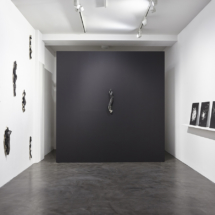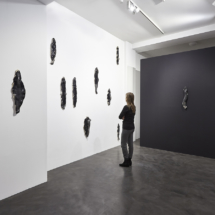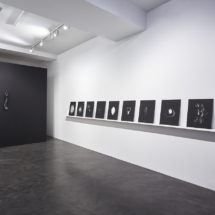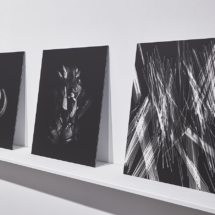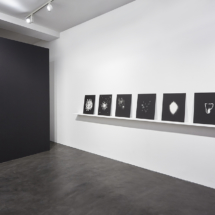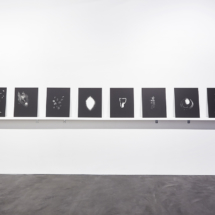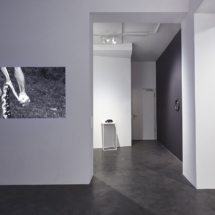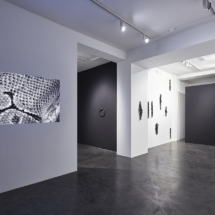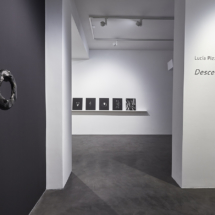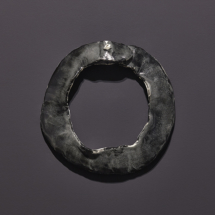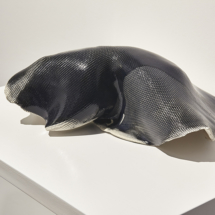Descent
Lucía Pizzani
Private View/Opening: 20 January, 6-9pm
Exhibition: 21 January - 25 February 2017
Over the past five years, Lucía Pizzani has been inexhaustibly developing a series of projects that
focus simultaneously on historical or literary narratives revolving around female figures and in the ongoing processes of biological transformation found in the natural world. In each of her projects, the collision of these seemingly disparate areas of interest generates a multifarious body of works spanning a variety of mediums – including photography, ceramics, videos, drawings, performances and installations – in which the female body takes centre stage. But far from the idealised and fetishised images of this body as traditionally disseminated through Western art and media, Pizzani’s pieces present us with pulsating organic forms that are at once arrestingly erotic and almost abject; bodies as living organisms in a constant state of becoming.
Previous exhibitions have explored the possible connections between a suffragette attack on an orchid greenhouse at the Kew Gardens in 1913 and the ambiguous gender connotations attributed to these flowers (Orchis, Galería Fernando Zubillaga, Caracas, 2011); the funerary mask of a beautiful unknown maiden whose body was found in the river Seine around 1880, later becoming an object of cult amongst Belle Époque writers and its relationship with the metamorphic qualities of moths (Mariposario, Oficina#1, Caracas, 2013 and The Worshipper of the Image, Sala Mendoza, 2014); and investigations around the fungi kingdom inspired by author Beatrix Potter’s important contributions to the field of mycology, often overshadowed by the success of her literary work (A Garden for Beatrix, Cecilia Brunson Projects,
London, 2015).
It must be noted, however, that although these narrative threads provide a framework for each of Pizzani’s projects, they remain somehow latent in her works, in which an experimental and intuitive approach to materials is favoured against the didactic presentation of documental or textual evidence. Situated in the decades nearing the turn of the 20th century, the stories and events that underpin these projects speak more or less directly about a period when the position (and image) of women was rapidly changing in Western societies and women’s rights movements were gaining momentum. In Pizzani’s works, the idea of transformation is conveyed through objects and images with distinctly organic formal attributes that evoke the dynamic life cycle of species.
A sense of incompleteness and movement permeates her small ceramic sculptures modelled on chrysalis of several shapes (Capullo Series, 2013), whose intricate curves and orifices seem to capture fleeting instants in a state of transition, while the series of tintypes (Impronta Series: Julia, Anne, Patricia, Paola and Katherine, 2013) depicting female bodies enveloped by textured African fabrics suggest fictional ethnographic documentations of a lost tribe of Amazons who embody the spirit of caterpillars as part of a
mysterious ritual of metamorphosis. As such, one can argue that there is a prominently political stance in these bodies of works, insofar as they mobilise ideas around female identity and representation as an ongoing and open-ended work-in-progress that is absolutely as relevant today as it was a century ago.
Descent is Lucía Pizzani’s first solo exhibition at House of Egorn, and it presents a new body of works that once again intertwines references from the natural world with historical and cultural narratives, this time shifting the political focus into the currently desperate living conditions imposed by socio-economical collapse in Venezuela, the artist’s country of birth. Like many Venezuelans from her generation who experienced the rise of a populist regime and the growing curtailment of civil liberties under Chavez’s rule and beyond, Pizzani has been based abroad for several years. In spite of having the world’s largest oil reserves, the country now faces a rapidly contracting economy and inflation rates approaching 1,000 per cent, increasing levels of violence, as well as widespread food and medicine shortages, having reached unprecedented levels of humanitarian crisis.
In Descent, the artist explores the notion of decline through the image of the serpent and the various symbolic meanings associated to it in different cultures. In Western art historical iconography the figure of the snake appears most notably in depictions of the ‘Fall of Man’ as the trickster responsible for humanity’s degeneration, perhaps its most widespread connotation. The ancient Greeks, on the other hand, saw the animal as a symbol of regeneration and healing - the shedding of the skin signifying rebirth -, the exact opposite interpretation to Christian allegory. Pizzani appropriates these and several other symbolic narratives in a new video titled Ciclo (2016), in which a collection of found imagery related to the figure of the serpent is mixed together with darker material, such as the seemingly homemade video documentation of a smuggler skinning a snake and news images of civilians searching for food in a rubbish tip in contemporary Venezuela. Without sound or colour, this short film is a raw portrait of the daily violence inflicted upon a population living under a dictatorial regime and it sets the tone for what is perhaps the artist’s most personal exhibition. It is certainly her darkest, almost like an open wound that conveys the feeling of having to constantly fear for the wellbeing of friends and relatives who remained in her home country and not knowing whether there will ever be an end to self-exile.
As in previous projects, Pizzani eschews a literal approach, focusing instead in the careful manipulation of techniques and materials to produce works whose meaning remains suggestive and open-ended. Cuaimas (2016) is a new series of ceramic sculptures named after the largest poisonous snake in South America. In Venezuela, cuaima is also a pejorative slang commonly used to describe dominant, malicious or untrustworthy women: an important detail that adds yet another layer of associations to these works. The series maintains the characteristically organic aspect of earlier ceramics, but this time also displaying a textured surface achieved through the use of different types of fabric in the modelling stage that evokes the scaled skins of serpents. The tactile quality of these surfaces is further enhanced by the exclusive use of black enamelling in the pieces, which highlights the detailed designs at the same time as giving them a slimy look.
The final work in the exhibition is Cesta Básica (2016), a wall piece formed by a group of photograms made from different types of basic groceries listed by the Venezuelan government as the most essential items for a family’s monthly survival. Paradoxically, the country’s current supply crisis means that the value of one full cesta básica is now equivalent to 18 minimum wages, resulting in widespread hunger and child malnutrition. In Pizzani’s photographs, these foods have a certain spectral presence, appearing almost as impalpable objects of adoration and desire that constantly evade our grasp. Often bearing no identifiable resemblance to the original object, each composition in the piece is carefully constructed with the intention of
rendering these images almost abstract, and they achieve a surrealistic quality that is reinforced by the choice of a technique traditionally associated with this artistic movement.
In Descent, Lucía Pizzani parallels an intensive research into materials and their formal possibilities with the expansion of her political field of inquiry to produce a fragmented and multi-layered narrative around Venezuela’s decline from petro-power to humanitarian abyss. In spite of her country’s bleak prospects for the near future, Pizzani leaves us with a telling image at the end of the video Ciclo: the ouroboros - or the ‘tail devourer’ in Greek - which symbolises the cyclical nature of the universe, reminding us once more that everything is in a constant state of flux and transformation.
- Kiki Mazzucchelli
